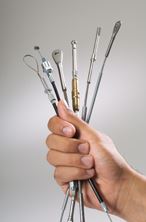 Four factors to consider when selecting wire rope
Four factors to consider when selecting wire rope
March 27, 2015 REDWIRE is news you can use from leading suppliers. Powered by FRASERS.
Posted by Bergen Cable Technology, Inc
Mfr Mechanical Cable, Cable Assemblies & Push-Pull Controls. Original Mfr Of Safety Cable, A Patented Fastener Reten... Read more
Subscribe
Free REDWIRE e-newsletter

Selecting the right wire rope for cable assembly requirements is a decision that should be given careful consideration. After all, the right wire rope can save a company money while ensuring the most effective design for the application.
Where do you start? There are four factors to consider: strength, safety, fatigue and wear.
1. Strength: Wire rope in service is subjected to several kinds of stresses — direct tension, acceleration, sudden or shock loads, bending or several forces acting at one time. For the most part, these stresses can be converted into terms of simple tension, and a rope of approximately the correct strength can be chosen. As the strength of a wire rope is determined by its, size, grade and construction, these three factors should be considered. But the key is to make sure the strength is sufficient enough to take care of the maximum load that may be applied, with a proper safety factor.
2. Safety: The safety factor is the ratio of the strength of the rope to the working load. A wire rope with a strength of 10,000 pounds and a total working load of 2,000 pounds would be operating with a safety factor of five. It is not possible to set safety factors for the various types of wire rope using equipment, as this factor can vary with conditions on individual units of equipment. The proper safety factor depends not only on the loads applied, but also on the speed of operation, shock load applied, the type of fittings used for securing the rope ends, the acceleration and deceleration, the length of rope, the number, size and location of sheaves and drums, the factors causing abrasion and corrosion, and the facilities for inspection.
3. Fatigue: Fatigue failure of the wires in a wire rope is the result of the propagation of small cracks under repeated applications of bending loads. It occurs when ropes operate over comparatively small sheaves or drums. The repeated bending of the individual wires, as the rope bends when passing over the sheaves or drums, and the straightening of the individual wires, as the rope leaves the sheaves or drums, causes fatigue. The best means of preventing early fatigue of wire ropes is to use sheaves and drums of adequate size. To increase the resistance to fatigue, a rope of more flexible construction should be used, as increased flexibility is secured through the use of smaller wires.
4. Abrasive wear: The ability of a wire rope to withstand abrasion is determined by the size, the carbon and manganese content, the heat treatment of the outer wires and the construction of the rope. The larger outer wires of the less flexible constructions are better able to withstand abrasion than the finer outer wires of the more flexible ropes. The higher carbon and manganese content and the heat treatment used in producing wire for the stronger ropes, make the higher grade ropes better able to withstand abrasive wear than the lower grade ropes.
Carefully consider the importance of these four requirements and select the rope that has the qualities best suited to withstand the effects of continued use.
For more information on wire ropes, contact Fairfield, N.J.-based Bergen Cable Technology, a leading provider of wire rope and mechanical cable assemblies.
Share
Posted by Bergen Cable Technology, Inc
Mfr Mechanical Cable, Cable Assemblies & Push-Pull Controls. Original Mfr Of Safety Cable, A Patented Fastener Reten... Read more
